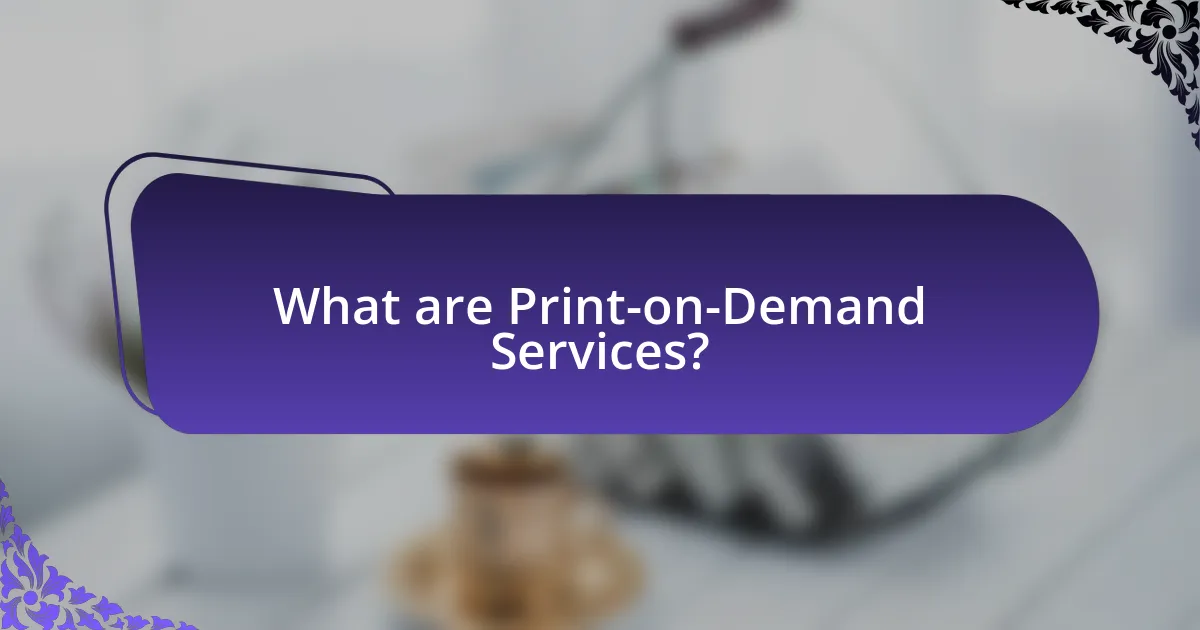Print-on-Demand (POD) services represent a transformative business model for publishers, allowing them to print products only after an order is placed, thereby reducing inventory costs and financial risks. This article explores the operational mechanisms of POD, the technology involved, and the key players in the industry, highlighting its growing popularity among publishers due to its cost-effectiveness and flexibility. Additionally, it examines market trends driving demand, the benefits and challenges of POD, and best practices for publishers to maximize its advantages. The discussion also includes strategies for ensuring high-quality outputs and effective marketing approaches tailored for POD publications.

What are Print-on-Demand Services?
Print-on-Demand services are a business model that allows individuals or companies to print products, such as books, apparel, or merchandise, only after an order is placed. This model eliminates the need for large inventory and upfront costs, as products are created in response to customer demand. According to a report by IBISWorld, the print-on-demand industry has seen significant growth, with a market size of approximately $1 billion in the United States as of 2021, highlighting its increasing relevance in the publishing and retail sectors.
How do Print-on-Demand Services operate?
Print-on-Demand (POD) services operate by allowing publishers and creators to print products, such as books or merchandise, only after an order is placed, eliminating the need for large inventory. This model utilizes digital printing technology, which enables quick production and customization of items based on customer demand. For instance, when a customer orders a book, the POD service prints a single copy, binds it, and ships it directly to the customer, thus reducing upfront costs and storage requirements for publishers. According to a report by IBISWorld, the POD industry has seen significant growth, reflecting its efficiency and appeal to independent authors and small publishers who benefit from lower financial risk and increased flexibility in their offerings.
What technology is involved in Print-on-Demand Services?
Print-on-Demand services utilize digital printing technology, which allows for the immediate production of printed materials as orders are received. This technology includes high-resolution inkjet and laser printers that can produce high-quality prints on various substrates. Additionally, Print-on-Demand platforms often integrate with e-commerce systems, enabling automated order processing and inventory management. The use of these technologies facilitates cost-effective, low-volume printing, eliminating the need for large print runs and storage, thus providing flexibility for publishers.
What are the key players in the Print-on-Demand industry?
The key players in the Print-on-Demand industry include companies such as Printful, Printify, and Lulu. Printful is known for its wide range of customizable products and integration with e-commerce platforms, while Printify offers a large network of print providers to optimize shipping and production. Lulu specializes in self-publishing and provides authors with tools to create and distribute their books. These companies dominate the market due to their technological capabilities, extensive product offerings, and strong partnerships with online retailers, making them essential for publishers seeking efficient print-on-demand solutions.
Why are Print-on-Demand Services gaining popularity among publishers?
Print-on-Demand services are gaining popularity among publishers primarily due to their cost-effectiveness and flexibility. These services eliminate the need for large upfront investments in inventory, allowing publishers to print books only as orders are received. This model reduces storage costs and minimizes the risk of unsold stock, which is particularly beneficial for independent and small publishers. According to a report by IBISWorld, the Print-on-Demand industry has seen significant growth, with a projected annual growth rate of 5.2% from 2021 to 2026, indicating a strong market demand. Additionally, the ability to offer a wider variety of titles without the constraints of traditional printing methods enables publishers to cater to niche markets effectively.
What market trends are driving the demand for Print-on-Demand?
The demand for Print-on-Demand (POD) is driven by several key market trends, including the rise of e-commerce, consumer preference for personalized products, and the increasing need for sustainable printing solutions. E-commerce growth has led to a surge in online shopping, with the global e-commerce market expected to reach $6.3 trillion by 2024, creating a need for flexible printing options that POD offers. Additionally, consumers increasingly seek unique and customized items, with 36% of consumers expressing interest in personalized products, which POD can efficiently provide. Lastly, the shift towards sustainability is evident, as 70% of consumers prefer brands that are environmentally friendly, prompting publishers to adopt POD to minimize waste and reduce inventory costs.
How do consumer preferences influence the growth of Print-on-Demand Services?
Consumer preferences significantly influence the growth of Print-on-Demand (POD) services by driving demand for personalized and unique products. As consumers increasingly seek customized items, POD services cater to this desire by allowing individuals to create tailored products without the need for large inventory investments. According to a report by Grand View Research, the global POD market is expected to reach $10.62 billion by 2025, largely fueled by consumer trends favoring personalization and sustainability. This shift in consumer behavior towards unique, on-demand products encourages publishers to adopt POD models, thereby expanding their offerings and reaching niche markets effectively.

What are the key benefits of Print-on-Demand Services for publishers?
Print-on-Demand (POD) services offer several key benefits for publishers, including reduced inventory costs, increased flexibility, and the ability to reach a global audience. By eliminating the need for large print runs, publishers can save on storage and production expenses, as they only print books when orders are placed. This model allows for quick adjustments to content and design, enabling publishers to respond to market trends and reader preferences more effectively. Additionally, POD services facilitate distribution to international markets without the complexities of managing physical inventory, thus broadening the potential customer base. These advantages contribute to a more efficient and cost-effective publishing process.
How does Print-on-Demand reduce upfront costs for publishers?
Print-on-Demand reduces upfront costs for publishers by eliminating the need for large print runs and inventory storage. Traditional publishing requires significant investment in printing thousands of copies upfront, which can lead to excess inventory and financial risk. In contrast, Print-on-Demand allows publishers to print books as orders are received, minimizing initial expenses and reducing waste. This model enables publishers to allocate resources more efficiently, as they only pay for the production of books that are sold, thereby lowering the financial barrier to entry for new titles.
What financial advantages do Print-on-Demand Services offer?
Print-on-Demand Services offer significant financial advantages, primarily by eliminating upfront inventory costs. Publishers can produce items only as orders are received, which reduces the risk of unsold stock and associated storage expenses. Additionally, these services often require no minimum order quantities, allowing for greater flexibility in production and cash flow management. According to a study by the Print-on-Demand Association, businesses utilizing these services can save up to 30% on production costs compared to traditional printing methods, further enhancing profitability.
How does Print-on-Demand minimize inventory risks?
Print-on-Demand minimizes inventory risks by allowing publishers to produce items only as they are ordered, eliminating the need for large upfront inventory investments. This model reduces the likelihood of overproduction and unsold stock, which can lead to financial losses. According to a study by the Print-on-Demand Association, businesses utilizing this model report a 30% reduction in inventory costs compared to traditional printing methods, demonstrating its effectiveness in managing inventory risks.
What impact does Print-on-Demand have on publishing timelines?
Print-on-Demand significantly accelerates publishing timelines by eliminating the need for large print runs and inventory management. Traditional publishing often requires months for printing, warehousing, and distribution, whereas Print-on-Demand allows authors and publishers to produce books as orders come in, reducing the time from manuscript completion to market availability to just days or weeks. This model enables quicker response to market trends and reader demand, as evidenced by the rise of self-publishing platforms that utilize Print-on-Demand technology, allowing authors to publish their works almost immediately after final edits.
How does Print-on-Demand streamline the publishing process?
Print-on-Demand (POD) streamlines the publishing process by allowing authors and publishers to produce books only as they are ordered, eliminating the need for large print runs and inventory storage. This model reduces upfront costs and financial risk, as it enables immediate publication without the burden of unsold stock. Additionally, POD services often integrate with online platforms, facilitating easier distribution and access to a global market. According to a report by IBISWorld, the POD industry has seen significant growth, reflecting its efficiency and appeal to independent authors and small publishers.
What role does Print-on-Demand play in faster market entry?
Print-on-Demand (POD) significantly accelerates market entry by enabling publishers to produce books only when there is demand, eliminating the need for large upfront inventory investments. This model allows for rapid production and distribution, as titles can be printed and shipped directly to consumers without the delays associated with traditional printing methods. For instance, POD services can reduce the time from manuscript completion to market availability to as little as a few days, compared to weeks or months for conventional publishing. This efficiency is supported by advancements in digital printing technology, which facilitate quick turnaround times and lower costs, making it feasible for publishers to test new titles and respond swiftly to market trends.

What challenges do publishers face when using Print-on-Demand Services?
Publishers face several challenges when using Print-on-Demand (POD) services, including higher per-unit costs, limited customization options, and potential quality inconsistencies. The per-unit cost of POD is typically higher than traditional printing methods, which can affect profit margins, especially for lower-volume titles. Additionally, POD services may offer limited options for customization, such as binding types or paper quality, which can restrict a publisher’s ability to create unique products. Quality inconsistencies can arise due to variations in printing technology and materials used by different POD providers, leading to unpredictable results that may not meet a publisher’s standards. These challenges can complicate the publishing process and impact overall satisfaction with POD services.
What are the common pitfalls of Print-on-Demand Services?
Common pitfalls of Print-on-Demand services include high production costs, limited customization options, and quality inconsistencies. High production costs can arise from low economies of scale, making it expensive to produce single items compared to bulk printing. Limited customization options may restrict publishers from offering unique designs or formats, which can hinder market differentiation. Quality inconsistencies often occur due to varying print technologies and materials used by different providers, leading to unpredictable product outcomes. These factors can negatively impact customer satisfaction and overall profitability for publishers utilizing Print-on-Demand services.
How can quality control issues arise in Print-on-Demand?
Quality control issues in Print-on-Demand can arise from several factors, including inconsistent printing processes, variations in material quality, and inadequate quality checks. Inconsistent printing processes may lead to differences in color accuracy and image resolution, affecting the final product’s appearance. Variations in material quality, such as paper type or ink, can result in products that do not meet customer expectations. Additionally, inadequate quality checks during production can allow defective items to be shipped, further compromising quality. These factors collectively contribute to the potential for quality control issues in Print-on-Demand services.
What logistical challenges do publishers encounter with Print-on-Demand?
Publishers encounter several logistical challenges with Print-on-Demand, including inventory management, shipping costs, and production timelines. Inventory management becomes complex as publishers must balance the need for immediate availability with the risk of overproduction, which can lead to increased costs. Shipping costs can vary significantly based on the location of the print facilities and the distribution channels used, impacting overall profitability. Additionally, production timelines can be unpredictable, as delays in printing or shipping can affect the timely delivery of books to customers. These challenges necessitate careful planning and coordination to ensure efficient operations in the Print-on-Demand model.
How can publishers effectively integrate Print-on-Demand into their business model?
Publishers can effectively integrate Print-on-Demand (POD) into their business model by adopting a hybrid publishing approach that combines traditional and digital methods. This integration allows publishers to reduce inventory costs and minimize waste by printing books only when orders are placed, which is supported by the fact that the global POD market is projected to reach $2.62 billion by 2027, indicating a growing demand for this service. Additionally, publishers should leverage technology platforms that facilitate seamless order processing and fulfillment, ensuring a smooth customer experience. By utilizing data analytics, publishers can also identify trends and optimize their offerings based on consumer preferences, further enhancing their business model.
What strategies can publishers use to maximize the benefits of Print-on-Demand?
Publishers can maximize the benefits of Print-on-Demand (POD) by implementing targeted marketing strategies, optimizing inventory management, and leveraging data analytics. Targeted marketing strategies, such as utilizing social media and email campaigns, can effectively reach niche audiences, increasing sales and visibility. Optimizing inventory management allows publishers to reduce costs associated with unsold stock, as POD eliminates the need for large print runs. Leveraging data analytics enables publishers to track sales trends and customer preferences, informing future publishing decisions and enhancing overall profitability. These strategies collectively enhance the efficiency and effectiveness of POD services, leading to increased revenue and reduced waste.
How can publishers choose the right Print-on-Demand partner?
Publishers can choose the right Print-on-Demand partner by evaluating key factors such as print quality, pricing, distribution options, and customer service. High print quality ensures that the final product meets industry standards, while competitive pricing affects profitability. Distribution options should align with the publisher’s target market, allowing for efficient delivery. Additionally, responsive customer service is crucial for resolving issues quickly and maintaining a smooth workflow. According to a survey by the Independent Book Publishers Association, 70% of publishers prioritize print quality and customer support when selecting a Print-on-Demand partner, highlighting the importance of these criteria in the decision-making process.
What best practices should publishers follow when utilizing Print-on-Demand Services?
Publishers should prioritize quality control, efficient inventory management, and effective marketing strategies when utilizing Print-on-Demand services. Quality control ensures that the final product meets industry standards, which is crucial for maintaining a good reputation; for instance, using professional design software and conducting proof reviews can significantly reduce errors. Efficient inventory management is essential, as Print-on-Demand eliminates the need for large stockpiles, allowing publishers to respond quickly to market demand without incurring excess costs. Effective marketing strategies, such as leveraging social media and email campaigns, can enhance visibility and drive sales, as evidenced by the fact that targeted marketing can increase conversion rates by up to 30%. By adhering to these best practices, publishers can maximize the benefits of Print-on-Demand services.
How can publishers ensure high-quality outputs in Print-on-Demand?
Publishers can ensure high-quality outputs in Print-on-Demand by implementing rigorous quality control processes throughout the production cycle. This includes selecting reputable Print-on-Demand providers known for their high standards in printing and materials, as well as conducting thorough pre-press checks to verify that files meet technical specifications. Additionally, publishers should invest in professional design and formatting services to enhance the visual appeal and readability of their products. Research indicates that high-quality print materials can significantly impact customer satisfaction and sales, with studies showing that 70% of consumers prefer well-designed books over poorly produced ones. By focusing on these areas, publishers can maintain a consistent level of quality that meets market expectations.
What marketing strategies work best for Print-on-Demand publications?
Effective marketing strategies for Print-on-Demand publications include leveraging social media advertising, utilizing email marketing campaigns, and optimizing search engine visibility. Social media platforms like Facebook and Instagram allow targeted ads that can reach specific demographics, increasing visibility and sales. Email marketing enables direct communication with potential customers, fostering engagement and repeat purchases. Additionally, optimizing content for search engines through SEO techniques enhances discoverability, driving organic traffic to the publication’s website. These strategies are supported by data indicating that social media ads can yield a return on investment of up to 400%, and email marketing has an average open rate of 20%, demonstrating their effectiveness in reaching and converting audiences.



